
|
The IR-QA Angle Finder A Polish answer to the VA-1 |

|
My other articles related to the |
|
Prism SLR finders are great for eye-level photography, but a major pain (sometimes literally) when the camera must be positioned lower than at your chest level. This is where angle finders, angled optical systems attached to the finder eyepiece, come so handy. In addition to providing a more convenient (for some applications, that is) viewing angle, these finders often offer additional magnification of the viewed image, useful when the focusing is done manually, but not only. Olympus E-System users can purchase one such attachment made by Olympus, the VA-1 Varimagni Angle Finder. I was thinking about buying one, except that I wasn't sure about the 90° viewing angle; 45° seemed more convenient for most uses. Then I learned about a Polish photographer, Mr. Ireneusz Błaszczuk, who runs a professional Foto-Pryzmaton studio in the small and beautiful historic town of Zamość, making a good use of Olympus SLRs. He needed an angle finder for his tripod shooting, and didn't like the VA-1 too much. Having experience in applied optics, he decided to build his own angle finder. The effort was successful, and the word has spread around; he is now crafting these finders in small numbers for other photographers. |
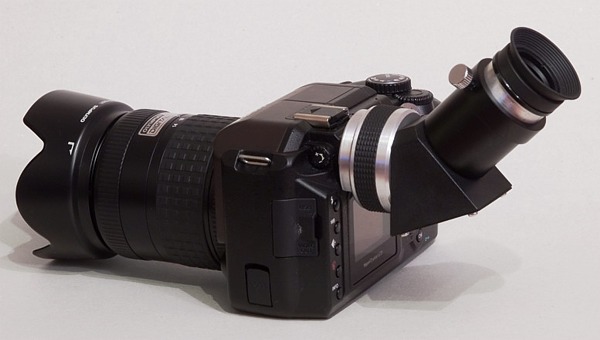
| |
| The IR-QA Angle Finder fitted on an E-300. Photo courtesy of the maker. |
|
Mr. Błaszczuk does not really advertise his product (and I doubt he will quit his daytime job any time soon); the only Web resource I was able to find is the discussion thread on a DP Review forum. When I contacted him by email, he answered all my questions, and said I can place an order, too, if I take my place in line. As the price was reasonable, and I the product looked promising, I decided to go for it. The line was not so long anyway, with three people ahead of me. In two weeks or so my IR-QA Angle Finder was ready and shipped to my wife's address in Poland, where she was spending the winter. It arrived in good shape, nicely and securely packed; a few weeks later, on a trip to Poland, I was able to pick it up and actually to try it out. Here are my impressions. Specifications The finder provides a 100% view of the screen in supported cameras (see below). The viewing angle is 45° from the eyepiece axis, and the attachment can be rotated 360°. The optical system (according to the maker, high-grade optical parts used in astronomy applications) provides a fixed magnification of about 1.7×. It has seven (!) optical elements (in addition to the prism). As expected from this kind of device, the viewed image is not inverted. Compatibility: Olympus E-1, E-300/330/500, Nikon D70, each via a separate adapter (one supplied), Canon D5 (this is a slightly different model, and more expensive, too). Weight: about 230 g (8 oz). Dimensions: less than 10 cm length, 4.5cm width, 8.5 cm height (measured with the device oriented as mounted on the camera). |
|
A close-up of the IR-QA mounted on the E-300. You can see the sliding tubus providing diopter adjustment, and the locking screw, as well as the rubber eyepiece/eyeglass protector.
You can clearly see how the 45° viewing angle is more convenient, for most applications at least, than 90° used in the VA-1. This luxury was, until now, available only to users of some medium-format cameras. |
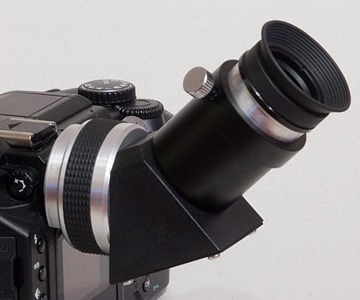
|
|
Another view; here you can clearly see the screw locking the attachment in its rotation around the axis of camera's finder eyepiece. The flat part with three screws slides straight onto the eyepiece mount of the E-300, E-330, and E-500.
The part at the right is the replacement adapter for the eyepiece bayonet mount of the E-1. |
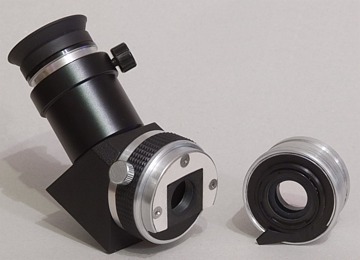
|
|
This diagram, supplied by the maker, shows the view field coverage when the IR-QA finder is mounted on the E-1.
On the E-300, the coverage will be almost identical; on the E-500 the corners will be entirely within the circle, as that camera has 10% less finder magnification. In both cases, however, I am skeptical about seeing the information sidebar (it is not visible in the VA-1 either, and, really, I find that display almost useless when using E-300 or E-500 when wearing glasses anyway). (All three photos supplied by Mr. Błaszczuk) |
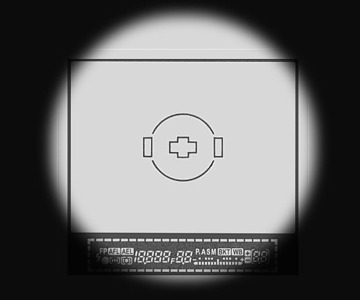
|
|
In use The thing is nicely made: old-fashioned, machined metal, no plastic, no corner-cutting. It mounts on the E-300/E-500 finder eyepiece fixture without a problem, sliding in with just the right amount of friction resistance. While some play may develop here with frequent use, I wouldn't worry about it; after all, you use the angle finder when the camera is mounted on a tripod. Mounting on the E-1 is with a special adapter which I haven't tried. Jerzy did, and found no problems. | |
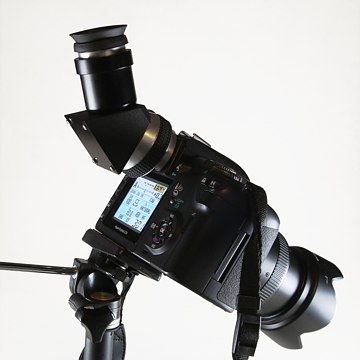
|
Here is the IR-QA Angle Finder mounted on my E-500 during a tabletop shooting session.
This shooting angle is quite inconvenient, if at all possible, with 90° angle finders like the Olympus VA-1. You can see that while the LCD display is partially obstructed by the IR-QA, it can still be seen whole, if in somewhat less convenient manner. (Picture taken with the Olympus C-5060WZ) |
|
Diopter adjustment is done by means of a sliding tubus, secured with a screw (i.e., not a helicoid). While this may, at the first glance, look like a minus, it is just a minor inconvenience: after all, you do it just once (or when the camera is used by another photographer), and it cuts down on cost, size, and mechanical complexity. There is also less chance of changing the adjustment by accident. When switching between the E-300 and E-500, I discovered that the IR-QA had to be re-adjusted each time, in spite of the fact that both viewfinders were tuned to my eyesight. Even so, I can live with the screw lock, no problem (or almost so). The adjustment process is made easier by the AF areas etched on the camera's screen. You may use these markers to find the best setting, as they are at the same apparent distance as the image shown on the screen. When you can clearly see that the AF markers and the center circle are etched with a thin, double line, you are in business; lock the screw. A similar screw locks the IR-QA in its rotation around the viewfinder axis — an operation needed when you change the image orientation between horizontal and vertical. Again, the mechanism is adequate for the job. The secondary eyepiece is quite large (about 22 mm across), but you have to keep your eye close to it to see the full screen.
I believe the centering can be adjusted to the particular camera model. The Olympus VA-1 angle finder also suffers from image cut-off at the left side when used on the E-300, by the way, and the effect is even more visible. Looks like the E-300 has the viewfinder slightly off-center in order to accommodate the vertical data display. Update of June, 2006: Next day after posting my impressions here I received an email from Mr. Błaszczuk, who recently found a supply of larger eyepieces for the IR-QA, providing a wider field of view. While not critical, this is a welcome improvement, and I will be able to try it in a few weeks. With this eyepiece (included into the new production run), IR-QA comes in two separate versions, optimized for use with and without glasses (no switching is possible), and you can specify in your order which version you need. When I get it, I will update this section. Update of August, 2006: No, I haven't seen the new eyepiece yet. Optically the IR-QA seems to be first-class; the finder image does not suffer any visible degradation going through it. I can see a very slight pincushion distortion; perhaps less of it than in the angle finders I've tried in the past with film cameras. I can't see any chromatic aberration or loss of sharpness. Very nice. Enlarging the visible finder image by a factor of 1.7× leads, obviously, to apparent scene brightness reduced by a factor of about 3×; there is no way around that. Under good light conditions (outdoors, studio, tabletop), however, the image is still bright and clear — and gloriously magnified! Actually, I was expecting it to be visibly dimmer; our eyes adjust really well to light conditions. In my tabletop, macro, and garden shooting sessions, the IR-QA proved to be a very useful accessory. Manual focusing is visibly easier, and so is critical image evaluation. The 45° viewing angle is, indeed, much more practical than 90°. I haven't used it yet for chest-level, tripod-based portrait shooting, but I have no doubt it will prove itself there as well. If you are planning to do any significant amount of that kind of shooting with your Olympus E-System SLR, I can recommend the IR-QA as a worthwhile investment. It is not cheap, but this is normal for this type of accessories. It is well-made and it does its job well (plus the 45° viewing angle is a great advantage). How to get it?
This, actually, seems to be the hard part. Mr. Błaszczuk is not trying to conquer the world with the IR-QA; this seems more like doing a favor to his fellow photographers. You may contact him via email: The price is $170 or €140; shipping to the U.S. — a somewhat steep $30 (less or none within the European Union). If you are using the E-1, this will cost you an extra $20 (but you also get the E-300/E-500 adapter). You have to check what, if any, forms of payment does the maker accept in addition to bank transfer (this works, I am sure, but is inconvenient and costly in the States). A second opinion Before I could even put my hands on the finder, I received some remarks from Sape M. of the Netherlands: Mine arrived yesterday. I tried it out on my E-500 and it works like a charm. It sticks out 95 mm measured perpendicularly to the back side of the camera. The prism box is 40 mm wide, the diameter of the rubber ring near the camera back is 48 mm. The width of the device including the screws is 55 mm. Weight is 230 g. The whole viewfinder image is visible and, if you look a bit to one side, you can see about half of the [data] display to the right [...]. Manual focusing directly through the viewfinder [alone] is almost impossible. Through the angle finder it is still a bit challenging, but it's probably possible enough, given that the depth of view is always better than that of a 35 mm camera. It fits snugly over the ridge on the viewfinder. I worry slightly that sliding it on and off might make some scratches around the viewfinder, but then my camera is for taking photos, not for being pretty. [With the finder mounted] the rear display becomes much harder to read, but none of it is covered, as long as you're prepared to get your head below the camera. That's an effort I'll just make. I ordered mine on March 25 and [...] it arrived [on] May 2nd at my Amsterdam address. It was tightly wrapped in bubble plastic and shipped in an envelope. Given the sturdiness of the device, that's good enough. I haven't been able to take it out yet for real photography, but I'm pretty sure I'll use it often. It's beautifully made. I paid 140 euro + 17 euro shipping, [transferring] the money directly to his bank account [...]. Four more Readers also reported having purchased the IR-QA, and in all cases their impressions were equally positive. | |

|
My other articles related to the |
|
Olympus® is a registered trademark of Olympus Corporation.
This page is not sponsored or endorsed by Olympus (or anyone else) and presents solely the views of the authors. |
| Home: wrotniak.net | Search this site | Change font size |
| Posted 2006/04/29; last updated 2006/08/16 | Copyright © 2006 by J. Andrzej Wrotniak |